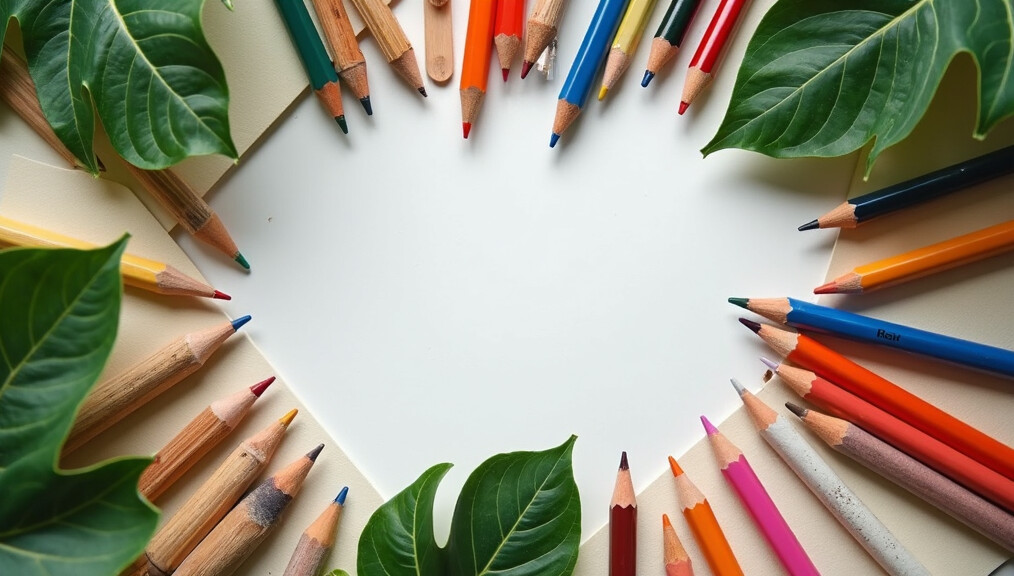Creating art shouldn’t come at the cost of the planet. That’s why I’m all in on eco-friendly art supplies – they help me express myself while being kinder to the environment. These days, there are plenty of options made with safer ingredients, fewer plastics, and more recycled or renewable materials. In this post, I’ll walk you through what makes art supplies eco-friendly, share some favourites, and offer practical tips for making greener choices as a creative.

Why Eco-Friendly Art Supplies Matter
Choosing eco-friendly art supplies isn’t about chasing a trend – it’s about being mindful of the bigger picture. Every brushstroke or pencil mark has a backstory, from how the materials were sourced to how they end up once we’re done.
When I choose supplies made from natural, biodegradable, or recycled materials, I’m protecting both my health and the environment. Traditional art products often contain petroleum-based plastics, toxic pigments, or harsh solvents that aren’t safe to rinse down the sink, and the plastic packaging adds up fast.
The good news? More and more brands are stepping up because they know artists care. That means better options are out there, and the list keeps growing.
Categories of Eco-Friendly Art Supplies
Let’s break it down. There’s a wide world of eco art gear out there, but here are some of the main categories I turn to:
✏️ Pencils & Drawing Tools
Many eco pencils use wood from sustainably managed forests or even recycled paper. I love options with natural graphite or earth-based pigments. And some come with little surprises—like seeds you can plant when you’re done!
🎨 Paints & Inks
Water-based paints and veggie-derived inks are my go-to when I want non-toxic options. I look for watercolour and gouache made with mineral or plant-based pigments and natural binders like gum arabic. Skip the heavy metals and go for brands that use natural preservatives.
📓 Paper & Sketchbooks
Recycled paper is a staple in my studio. I lean toward sketchbooks made from post-consumer waste or cotton rags. If they’re chlorine-free and acid-free, that’s even better, great for both the planet and the longevity of my work.
🖌 Brushes & Tools
While synthetic brushes usually rely on fossil fuels, there are now great alternatives made from recycled materials or with bamboo/sustainable wood handles. For texture and mixed media, I also use natural sponges, bamboo charcoal, and bone folders.
🧷 Adhesives & Mediums
I avoid solvent-based glues and go for water-based, starch, or cellulose formulas instead. They’re easier on the environment and on me.
How to Spot Truly Eco-Friendly Supplies
Let’s be honest – some labels can be misleading. Here’s what I look for when choosing my supplies:
- Certifications: FSC, Green Seal, AP Non-Toxic, or Cradle to Cradle.
- Ingredients: I go for plant, mineral, or water-based and avoid petroleum, heavy metals, or strong solvents.
- Packaging: Less is more. I look for recycled or minimal packaging, and love when brands offer bulk or refills.
- Longevity: If it lasts longer, it reduces waste. Simple.
A quick search or reading reviews goes a long way in helping me pick tools that align with my eco values.
The Real Challenges (And How I Handle Them)
Switching to eco art supplies hasn’t always been seamless. Here’s what I’ve noticed, and what works for me:
💸 Price & Availability
Eco products can be a bit more expensive and aren’t always easy to find locally. I shop online, buy in bulk, and check for local art supply swaps or secondhand gems.
🧪 Performance
Some eco-friendly materials behave differently. For example, plant-based paints might have different textures or dry slower. I test them on smaller projects first, and sometimes mix them with traditional ones if needed.
🗂 Limited Selection
Sometimes the eco options feel a bit slim, especially in smaller stores. That’s when I jump into online communities or reach out to the brands directly. Artist forums are gold mines for honest feedback.
Start Small – It All Adds Up
You don’t have to switch everything overnight. I started by replacing things as I ran out. One greener notebook here, a better brush set there, it all helps. Over time, these little swaps make a big impact.
Greener Habits in Your Creative Routine
Eco-friendly isn’t just about what we buy, it’s also about how we create.
- Reuse & Upcycle: I repurpose jars, cardboard, old fabric, and scraps into canvases, storage, or mixed-media projects.
- Save Water: I rinse brushes in one container and avoid sending acrylics down the drain. Wiping excess paint on a rag before washing makes cleanup easier and greener.
- Swap & Share: Swapping supplies with friends or joining local art groups is a great way to cut down on waste and try new tools.
And for an extra creative twist? I sometimes DIY my own supplies – like homemade inks or natural glue alternatives.
FAQ: What People Ask About Eco Art Supplies
Q: Are eco-friendly art supplies more expensive?
A: Sometimes, yes – but they often last longer or perform better, so it balances out. Buying in bulk or catching sales helps too.
Q: Can I mix eco and traditional supplies?
A: Definitely. I still do. It’s not about being perfect – it’s about progress. Every eco choice counts.
Q: Where can I buy them?
A: Specialty art stores, eco shops online, and even big craft chains are starting to carry them. Artist communities are great for finding new recs!
Brands I Love (and think you will too)
🖍 Colour & Co by Crayola – Plant-based markers and recycled packaging
✏ Faber-Castell – Sustainably harvested wood + water-based varnish
🎨 Natural Earth Paint – Gorgeous mineral pigments + compostable kits
📒 Ecology Paper – 100% recycled and chlorine-free sketchbooks
🖌 Princeton Catalyst – Brushes made from recycled synthetics and FSC handles
Tip: Try starter kits or samples if you’re new to these brands. You don’t have to go all in to get a feel for what suits your style.
Creating with a Clearer Conscience
For me, being a sustainable artist isn’t about being perfect, it’s about being mindful. I focus on making steady, thoughtful choices: using what I have, trying greener options, and learning as I go.
If you’re thinking about switching things up, don’t stress. Start small, stay curious, and enjoy the process. Eco-friendly art isn’t just good for the planet – it’s often more inspiring, too.
So go ahead – paint, draw, sketch, and sculpt in a way that supports your creativity and the world around you.
